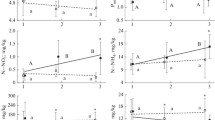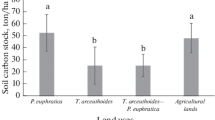Abstract
On a Vertisol under 850 mm rainfall, at an altitude of 1850 m, Faidherbia albida trees that occurred at 6.52 trees ha−1, with a canopy cover that range from 97 m2 ha−1 to 229 m2 ha−1 were recorded. Studies on the lateral and vertical influence of the tree canopy on some physical and chemical properties of the soil, show apparent higher organic matter on the West side of the tree than the East due to accumulated wind blown litter by prevalent wind direction, and organic matter, N, P and K levels were higher under the tree canopy than outside for all directions and depths studied. Soil pH, exchangeable Na, Ca and Mg under the canopy and outside were similar. Available water capacity was 1.5 to 2 times more under than outside the tree. Noticeable increases in the silt fraction under the tree was recorded and discussed in relation to soil condition improvement and plant growth.
Similar content being viewed by others
References
Ahmad N (1984) Vertisols. In: Wilding LP, Smeck NE and Hall GF, eds, Pedogonesis and Soil Taxonomy. II. The Soil orders, Development in Soil Science. IIB, pp 91–123. Elsevier Science, Amsterdam
Baumer M (1986) The potential role of Agroforestry in combating desertification and environmental degradation with spatial reference to Africa. ICRAF, Nairobi; CTA, Wageningen, 250 pp
Charreau C and Vidal P (1965) Influence de L'Acacia albida (Del.) sur le sol, nutrition Mineral et Rendements des mils Pennisetum au Senegal. L'Agronomie Tropical 67: 600–627
CIFT (1989) Faidherbia (Del.) A Chev (Synonym: Acacia albida Del.) A monograph. CTFT, Nogent sur Marne Cedex France, 66 pp
Danchette C and Poulain JF (1969) Influence de L'Acacia albid sur les facteurs pedoclimatiques et les rendements de cultures. Sols Afr. 14: 143–184.
Dudal RC, ed, (1965) Dark Clay Soils of Tropical and Subtropical Regions. FAO Agricultural Development Paper No. 83. FAO, Rome, 161 pp
Giffard PL (1964) Les possibilities de reboisement en Acacia albida au Senegal. Rev. Bois et Forêts des Tropics 95: 21–23
Giffard PL (1971) Recherches complementaires sur Acacia albida (Del.) Bois et Forêts des Tropiques, Janvier — Fevrier No. 135: 3–20
Giffard PL (1974) Les essences de reboisement au Senegal. Le Kad, Acacia albida (Del.) (Faidherbia albida chev.) CTFT, Senegal
Giffard PL (1974) L'arbre dans le paysage Senegalais; silviculture en zone Tropicale seche. CTFT, Dakar, 431 pp
Jung G (1967) Influence de L'Acacia albida (Del.) Sur la Biologie del Sols Dior. Report Office de la Rescherche Scientifique et Technique outre — Mer De Dakar — Hann, 66 pp
Jung G (1969) Cycles biochemiques dans un ecosysteme de region tropical Seche. Acacia albida (Del.) sol ferrugineux tropical per lessive (Dior) (note preliminary). Oecologia Plantarum 4: 195–210
Jutzi S, Anderson FM and Abiye Astatke (1987) Low-cost modification of the traditional Ethiopian tine plough for land shaping and surface drainage of heavy clay soil: preliminary results from on-farm verification trials. ILCA Bulletin 27: 28–31
Kamara CS and Haque I (1987) Characteristic of Vertisols at ILCA Research and outreach sites in Ethiopia. PSD Working Document No. B5. International Livestock Centre for Africa (ILCA) Addis Ababa, Ethiopia, 87 pp
Kazmin V (1973) The geological map of Ethiopia. I.E.G. Ministry of Mines. Addis Abada, Ethiopia
Le Houérou HN (1980) Agroforestry techniques for the conservation and improvement of soil fertility in arid and semi-arid zones. In: ‘Browse’ in Africa. Proc. Symp. (Le Houérou HN, ed), pp 433–435
Maydell H-J Von (1986) Trees and shrubs of the Sahel: their characteristics and uses. GTZ, Eschborn, 525 pp
Miehe S (1986) Acacia albida and other multipurpose trees on the Fur farmlands in the Jebel Marra highlands, Western Darfur, Sudan. Agroforestry Systems 4: 89–199
Poschen P (1986) An evaluation of the Acacia albida-based agroforestry practices in the Hararghe highlands of Eastern Ethiopia. Agroforestry Systems 4: 129–143
Radwanski SA and Wickens GE (1967) The ecology of Acacia albida on Mantle soils in Zalinga, Jebel Marra, Sudan. J Appl Ecol 4: 569–579
Zinke PJ (1962) The pattern of influence of individual trees on soil properties. Ecology 43: 131–133
Author information
Authors and Affiliations
Rights and permissions
About this article
Cite this article
Kamara, C.S., Haque, I. Faidherbia albida and its effects on Ethiopian highland Vertisols. Agroforest Syst 18, 17–29 (1992). https://doi.org/10.1007/BF00114814
Issue Date:
DOI: https://doi.org/10.1007/BF00114814




